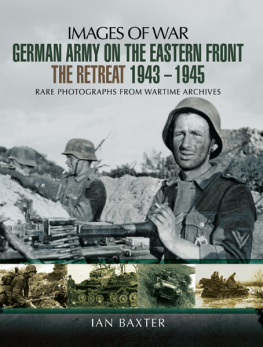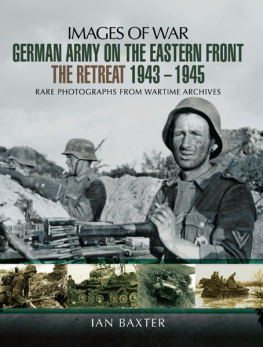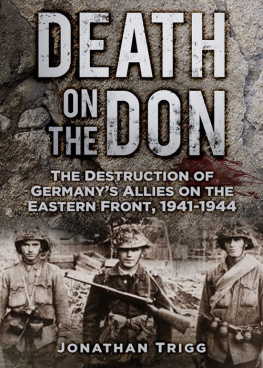The German Army on the Eastern Front
An Inner View of the Ostheer s Experiences of War
Jeff Rutherford and Adrian E. Wettstein
First published in Great Britain in 2018 by
Pen & Sword Military
an imprint of
Pen & Sword Books Ltd
47 Church Street
Barnsley
South Yorkshire
S70 2AS
Copyright (c) Jeff Rutherford and Adrian E. Wettstein 2018
ISBN 978-1-47386-174-9
eISBN 978-1-47386-176-3
Mobi ISBN 978-1-47386-175-6
The right of Jeff Rutherford and Adrian E. Wettstein to be identified as Authors of this Work has been asserted by them in accordance with the Copyright, Designs and Patents Act 1988.
A CIP catalogue record for this book is available from the British Library
All rights reserved. No part of this book may be reproduced or transmitted in any form or by any means, electronic or mechanical including photocopying, recording or by any information storage and retrieval system, without permission from the Publisher in writing.
Pen & Sword Books Ltd incorporates the imprints of Pen & Sword Archaeology, Atlas, Aviation, Battleground, Discovery, Family History, History, Maritime, Military, Naval, Politics, Railways, Select, Social History, Transport, True Crime, and Claymore Press, Frontline Books, Leo Cooper, Praetorian Press, Remember When, Seaforth Publishing and Wharncliffe.
For a complete list of Pen & Sword titles please contact
PEN & SWORD BOOKS LIMITED
47 Church Street, Barnsley, South Yorkshire, S70 2AS, England
E-mail:
Website: www.pen-and-sword.co.uk
Contents
Introduction
For the English-speaking world, the German army of the Second World War is generally viewed through the prism of war against the Western Allies. The brilliance and audacity of German panzer commanders and their troops led to the shocking defeat of French and British forces in 1940, while the Africa Corps proved extremely vexing to British forces in North Africa. Even after defeats at El Alamein, Tunis, Salerno, and on the Normandy beaches, the German army mounted a tenacious defence symbolized by the battle of the hedgerows in Normandy, the defence of the Gothic Line, Arnhem and the Hrtgen Forest that precipitously slowed the Allied advance and, as the Battle of the Bulge illustrated, it still possessed the striking power to mount an offensive that threatened Allied positions. By the end of the war, however, the German army was a mere shell of the force that had conquered continental Europe. Certainly Allied actions both on the battlefield and in the air and at sea contributed to this state of affairs. Much more important in the grinding away of the German armys combat power and efficiency, however, was the war against the Soviet Unions Red Army.
From the beginning of the invasion on 22 June 1941 until the end of the war on 8 May 1945, the German army deployed the majority of its troops in the eastern theatre of war. As a result, this became not only the most decisive conflict of the Second World War, but also the largest in terms of size, scale, and totality. While the Sino-Japanese war approached the German-Soviet clash in terms of violence and breadth, the totality of the latter struggle was far and away the greatest of the Second World War. Modern industrialized war on the scale of the war in the East millions of men deployed at the front, well-equipped with cutting-edge weaponry, on a front that stretched from the Arctic Circle to the Caucasus mountains could only be undertaken by two countries who possessed the robust state structures needed to fuel such a war. This war was also given a much more ferocious edge than the one fought between the Germans and the Western Allies. In the east, Nazi ideological beliefs structured the manner in which Germany prosecuted the war and the racism that animated the Nazi state gave the war against the Soviet Union a brutal sheen that stretched from the highest levels of command down to the ordinary soldiers, and it was one that was reciprocated by Soviet state and society.
The German-Soviet war was essential in defeating Germany, the strongest of the Axis powers. While one cannot uncouple this theatre from the Allied war against Germany as a whole, it was here where the German army lost its backbone as continuous massive losses depleted the German manpower pool, decreasing the quality of officers and men alike. The Luftwaffe also suffered greatly in the East, and the use of trainer crews and flight teachers during the winter crises of 1941/42 and 1942/43 to fly supplies to encircled forces proved catastrophic to the German pilot training program. Of course, Anglo-American supply of the Soviet Union with weapons and goods of all kinds was essential for the Soviet war effort. Tanks and aircraft filled Soviet production gaps, especially in 1941/42, while other goods such as shoes helped in the mobilization effort of 1943/44. Furthermore, Western Allied aid allowed the Soviets to concentrate their production on fewer goods. It is doubtful that Soviet industry could have produced more than 100,000 tanks in the war, if it had to divert resources to for example locomotives and trucks, goods delivered en masse by the Western Allies. The Western Allies war effort additionally forced the Germans to devote considerable resources to the U-boat war, coastal and air defence in the west and in the skies over the Reich. Air defence of Germany alone included no fewer than 1,400 batteries of anti-aircraft guns and searchlights at the end of 1942, with many more stationed in France, Norway or in the Mediterranean. The men and material devoted to these tasks could therefore not be utilized in the East. These caveats aside, the bulk of the German armys fighting took place in the east and it was in this theatre that the army was ultimately destroyed.
Adolf Hitler and the German military leadership planned Operation Barbarossa the invasion of the Soviet Union as a short campaign, consciously designed to build upon the previous rapid, mobile operations in Poland, France and the Balkans. While many issues, including, most problematically, the primary strategic goal of the campaign, were not fully decided, the belief that the German offensive would achieve its goals in eight to twelve weeks notably led to a neglect of planning for logistics and replacements. Intelligence on the Soviet Union was criminally negligent and the military leadership completely underestimated the vastness of the theatre of operations and its terrain. In expectation of civilian authorities swiftly taking control of the conquered Soviet territories following the brief campaign, a military occupation policy was also not fully developed. When this short campaign failed to defeat the Soviet Union and losses in men and material increased to an unprecedented level, the army was forced to adapt in real time. In spite of these attempts to modify its practices, the German army never fully recovered from the losses of 1941, due largely to the scarcity of reserves in both men and material. While the crisis in the replacement system was overcome in 1942, a growing manpower shortage plagued the Germans for the remainder of the war. The issue of low-level leadership also became a nagging and eventually debilitating problem. In combination, these elements led to a steady decrease in German combat power, only partly compensated for by superior weapons that became available in larger numbers from 1942 onwards and a volatile Soviet battlefield performance. The defeat of the German offensive against Moscow in autumn 1941 also shaped the German war experience the majority of units and men would, after that point, primarily fight a defensive positional war.








